
Locust Point is a peninsular neighborhood in Baltimore, Maryland. Located in South Baltimore, the neighborhood is entirely surrounded by the Locust Point Industrial Area; the traditional boundaries are Lawrence street to the west and the Patapsco River to the north, south, and east. It once served as a center of Baltimore's Polish-American, Irish-American and Italian-American communities; in more recent years Locust Point has seen gradual gentrification with the rehabilitation of Tide Point and Silo Point. The neighborhood is also noted as being the home of Fort McHenry.
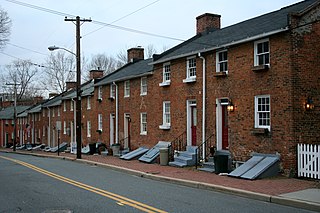
Oella is a mill town on the Patapsco River in western Baltimore County, Maryland, United States, located between Catonsville and Ellicott City. It is a 19th-century village of millworkers' homes.

Engine House No. 8 was a historic fire station located at Baltimore, Maryland, United States. It was a two-story masonry building with a cast-iron street front, erected in 1871 in the Italianate style. The front featured a simple cornice with a central iron element bearing the legend "No. 8". Engine Company No. 8 operated from this building until 1912. In 1928 it became the motorcycle shop of Louis M. Helm and the upper story functioned as a clubhouse for a series of boys’ clubs into the 1940s.
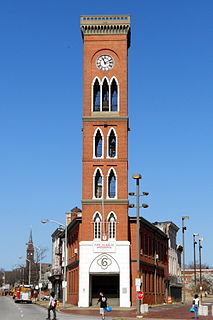
Engine House No. 6 is a historic fire station located at Baltimore, Maryland, United States. This two-story brick building features a 103-foot Italian-Gothic tower at the apex of its truncated triangular shape. It was built in 1853–54, and the tower is said to be a copy of Giotto's campanile in Florence, Italy.
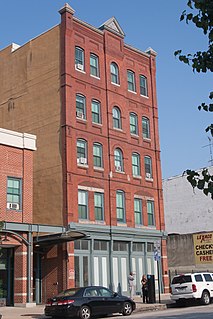
The Sanitary Laundry Company Building is a historic building located at Baltimore, Maryland, United States. It is a five-bay wide, five-story brick loft building constructed in 1883. The façade features a cast-iron storefront at street level and the elaborate decorative brickwork and terra cotta ornamentation on the upper floors reflect the influence of the Queen Anne style. It was built originally as a slaughterhouse and meat packing plant until 1897, when it was converted to a commercial laundry.
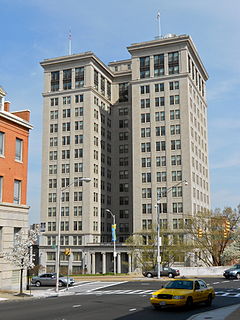
Standard Oil Building, also known as the Stanbalt Building, is a historic office building located at Baltimore, Maryland, United States. It is a 15-story Beaux Arts skyscraper designed by Clyde N. Friz (1867-1942), one of Baltimore's best-known Beaux Arts designers, and built in 1922. The steel-frame "U"-shaped office building is clad in limestone. It was built by the Standard Oil Company at a time when that business was once one of the nation's principal corporations, the dominant supplier of gasoline and fuels.

Erlanger Buildings is a historic loft building located at Baltimore, Maryland, United States. It consists of a four-structure, turn-of-the-20th-century loft complex. The buildings range in size from two to six stories high and feature iron storefronts and stone detailing. They were built between 1892 and 1910. The buildings served as the home of the Erlanger Manufacturing Company, which produced BVD brand underwear. Charles Erlanger, co-founder of the company, is credited with making major advances in the design of underwear which revolutionized the industry.

Gandy Belting Company Building is a historic loft building located at Baltimore, Maryland, United States. It is a brick masonry bearing-wall structure built in five sections. The sections built in 1888, 1890, and 1908 are four stories in height. The remaining two sections, built in 1908-1911 and 1911 respectively, are five stories in height. The Gandy Belting Company, (1888-1931) manufactureer of machinery belting.

Gunther Brewing Company is a historic brewery industrial building complex, located in the Canton neighborhood of southeast Baltimore, Maryland,. The site comprises 15 masonry buildings. The main structure is a five-story brick "L"-shaped Romanesque Revival-style brew house with a two-story brick ice plant built about 1910 and one- and two-story boiler room. Additional brew houses built in 1936 and 1950 are also on the property. The later Tulkoff factory and warehouse was built about 1964. It was home to the George Gunther, Jr. Brewing Company, founded in 1900. By 1959, it was the second largest brewery in Baltimore, one of the major centers of brewing in America, when it produced 800,000 barrels per year and employed approximately 600 people. Hamm's Brewing Company bought the Gunther Brewing Company in 1960, and later became part of Miller Brewing Company. Later the brand was acquired just three years later by the F. & M. Schaefer Brewing Company in 1963, the plant in Canton was closed in 1978. The Tulkoff company briefly used the factory for their sauce products at the conclusion of all brewing operations.

H.F. Miller & Son Tin Box and Can Manufacturing Plant, or the American Can Company, Miller Factory, and now Miller Court is a historic can manufacturing plant located at Baltimore, Maryland, United States. It was erected in three stages between 1890 and about 1910. It is a four-story brick manufacturing plant. The exterior features decorative brickwork, multiple window forms, and substantial construction typical of the period. The interior features chamfered posts, closely spaced joists, and fire doors.

Londontown Manufacturing Company, Inc., also known as Meadow Mill, is a historic cotton mill complex located at Baltimore, Maryland, United States. It is a three-story, Italianate brick structure that features a square tower structure with a truncated spire-like roof having an open bell cupola. It was erected in 1877 as one of five mills which comprised the Woodberry Manufacturing Company. It was intended for the manufacture of seine twines. It was home to London Fog, prior to its move to Eldersburg, Maryland.

Coca-Cola Baltimore Branch Factory is a historic factory complex located at Baltimore, Maryland, United States. It was constructed from 1921 to 1948 and built principally to house Coca-Cola's syrup-making operations. The complex is spread over a 9.4-acre (38,000 m2) site and includes a two-story brick syrup factory/sugar warehouse and an earlier two-story brick mattress factory that Coca-Cola acquired and adapted in the 1930s. Completed in 1948, the complex housed syrup-making operations as well as the Coca-Cola Company's chemistry department.

National Enameling and Stamping Company is a historic factory complex located at Baltimore, Maryland, United States. It was constructed in 1887 to serve as the works of the Baltimore branch of the nation's largest tinware manufacturer, the National Enameling and Stamping Company (NESCO). The densely packed complex fills an almost 5-acre (2.0 ha) site and consists of 17 interconnected buildings and one structure that vary in height from one to five stories. The complex was organized to house three primary functions in discrete sections: the manufacture of tinware, the manufacture of enameled and japanned wares, and storage, warehousing, and distribution. The plant ceased production of tinware and enameled wares in 1952.
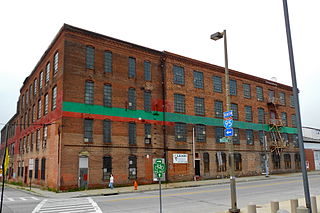
Parker Metal Decoration Company Plant is a historic factory building located at Baltimore, Maryland, United States. It is a steel-frame brick industrial building, ranging from one to three stories in height, and consists of five components built in stages between the first decade of the 20th century and the 1940s. The Parker Metal Decorating Company operated between 1921 and 1994.

Procter and Gamble Baltimore Plant is a historic factory complex located at Locust Point in Baltimore, Maryland, United States. It is a compact industrial complex built by the national corporation Procter & Gamble comprising five major three-story brick buildings spread over 10 acres (40,000 m2). These major buildings are the Process Building (1929), the Soap Chip Building (1929), the Bar Soap Building (1929), the Warehouse (1929), and the Tide Building (1949).
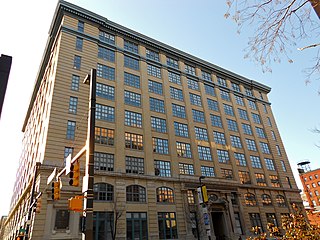
Sonneborn Building, also known as Paca-Pratt Building, is a historic loft building in Baltimore, Maryland, United States. Designed by Theodore Wells Pietsch, it is a nine-story loft building constructed in 1905 of "fireproof" reinforced-concrete construction, faced in buff-colored brick, with a coursed ashlar foundation and stone trim. Its detailing reflects the Neoclassical Revival of the early 20th century. It was built for Henry Sonneborn and Company as a vertical clothing manufactory and was the tallest and largest strictly manufacturing building in the city of Baltimore.

Hendler Creamery is a historic industrial complex in Jonestown, Baltimore, Maryland. Since it spans an entire block it has addresses at 1100 E. Baltimore St. and 1107 E. Fayette St. "The Hendler Creamery is historically significant for its contribution to the broad patterns of history in three areas of significance: transportation, performing arts, and industry."
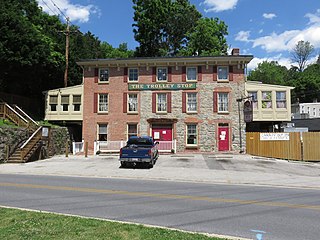
Ellicott's Mills Historic District is a national historic district at Oella, Baltimore County, Maryland, United States. It is on the east bank of the Patapsco River, opposite Ellicott City. It relates to the industrial operations of the Ellicott family from the 1770s through the mid-19th century. It consists of the sites of historic buildings including: an 18th-century building, a section of an 18th-century mill incorporated in a 20th-century factory, a 19th-century tavern, 19th-century workers housing, and an 1859 Italianate villa built by John Ellicott, united by the major east–west route in Maryland during the early 19th century, the old National Pike. Also in the district is the mammoth multi-story Wilkins-Rogers Company flour plant, which is located on the site of the 1792 Ellicott Flour Mill, the first merchant flour mill in the United States.

The American Ice Company is a historic ice manufacturing plant located at 2100 West Franklin Street in Baltimore, Maryland, United States. It is a large industrial brick building designed by Mortimer & Company and constructed by Fidelity Construction in 1910-11 for the American Ice Company, a business that manufactured and delivered ice throughout the Mid-Atlantic and South. The building is two stories, with the brick laid in American bond, and is 21 bays long. Three of those bays at one end of the building are slightly projected and topped by a stepped parapet, forming the entrance area of the building.























